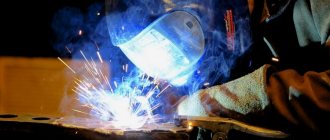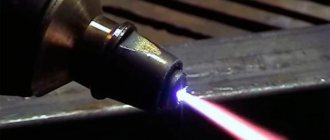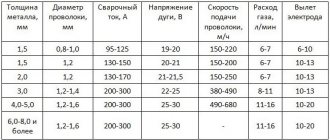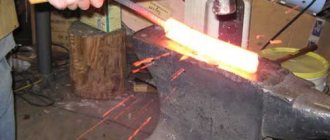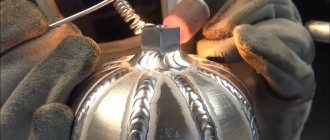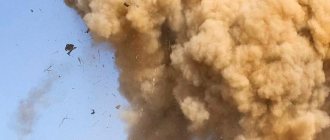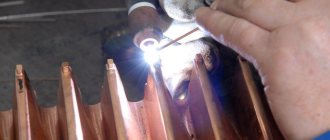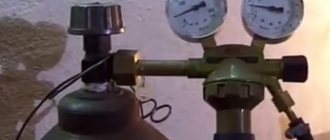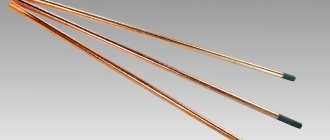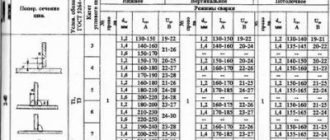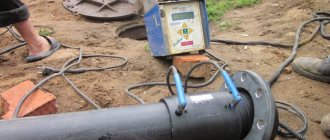This type of welding is used in various fields:
- construction of hydraulic structures;
- ship repair work;
- construction of special technical structures;
- laying of pipelines;
- construction of berths and port facilities;
- construction of platforms, drilling rigs, dams.
In this article we will look at the technological features of such a unique phenomenon as underwater welding.
Underwater welding: types
Welding metal underwater can be done in several ways. They can also be divided into two types, which differ significantly from a technological point of view: dry and wet welding .
The first category involves the use of special equipment. This equipment creates conditions under which the contractor has the opportunity to use devices and materials used on land. This includes underwater cameras, boxes, compartments, bells .
Wet welding is the making of a connection directly in an aqueous environment. In this case, both the work object and the welder are in the same element. Here, additional devices include electrodes for underwater welding and equipment, as well as the knowledge and experience of the performer.
This technology uses arc welding due to its widespread use among specialists. When working at depth, the welding arc releases a large amount of thermal energy and evaporates the water around it. This allows you to create a kind of sphere filled with gas. In this area, the arc continues to burn steadily, even under pressure.
Advantages : time saving; absence of large financial costs; The specialist is guaranteed freedom of movement. Disadvantage - the quality of the seam is much lower than when welding in a dry environment.
This species is also divided into two subspecies:
1. Semi-automatic welding . The specialist manually adjusts the direction of the mechanical supply of the electrode wire. Advantages: duration, continuity and better visibility of the process, the absence of coating on the wire allows better control over the formation of the seam, which ensures a more accurate and even connection, and also eliminates the formation of pores and the appearance of inclusions.
2. Manual welding . The contractor uses electrodes for underwater welding and mobile welding equipment to work in hard-to-reach places. To carry out such a complex process, special materials are used, developed and adapted to harsh conditions . Electrodes for welding in water have a waterproof coating, which is a film. The composition of the coating is supplemented with the following elements: resins, paraffin and celluloid varnish. These compositions do not allow the coating to become limp from exposure to water , and also create a protective layer.
Wet welding technology is used more often than dry welding method. The second method is less popular for several reasons:
- impressive financial costs;
- a long time for the construction and preparation of additional equipment.
However , the technology of underwater dry welding has the main advantage - the quality of the seam is at the same high level as a connection made on land.
Dry welding has several subtypes :
1. Welding in a deep underwater chamber (caisson/diving bell) . This technology involves submerging the camera under water. The caisson is hermetically secured around the work area. The contractor makes the connection inside the structure, in which atmospheric pressure is maintained by filling it with gas and displacing water. Advantages: a dry environment guarantees a high-quality seam; gradual cooling of the metal provides good impact strength.
Video
Here's what it might look like, watch the video.
[ads-pc-2][ads-mob-2]
2. The connection is made in a mobile dry box (hyperbaric welding/hydraulic welding). The hydrobox must be completely or partially made of transparent material, and must also fit tightly to the work area and ensure tightness. The box maintains a gaseous environment that displaces water. The base of the box is open for insertion of the welding head. Transparent walls allow the performer to control the process.
Kinds
Let us immediately highlight three types of electrodes that are often used in industry for underwater welding. Please note that this is not a complete list of brands with similar properties. Many craftsmen speak flatteringly about the electrodes of the German company ZELLER 555. We will consider only the products of the Russian manufacturer - TsM-7S, ANO-1 and OZS-3. They are intended not only for welding in water environments, but also meet all quality and safety requirements.
In the technical requirements board they are positioned as the usual consumables for manual arc welding. The inner rod is made of low carbon steel. There are no special differences in the composition of the coating, but it is applied to the rod in a thicker and more dense layer. It contains substances such as paraffin, celluloid varnish and some resins. They protect the coating from moisture, otherwise the coating will simply become limp. The diameter of the electrodes for underwater welding is 4-6 mm. The network voltage when connecting the welding machine can vary from 220 to 340 V.
Electrodes of the Broco brand may attract the attention of craftsmen. These electrodes are designed not only for welding, but also for cutting metals. Underwater welding can be done on carbon and stainless steel. The diameter of the electrodes can be different, it varies from 3.2 mm to 9.5 mm. The rod contains copper, which improves conductivity. The SofTouch series from broco is characterized by a high combustion temperature, reaching 5000°C degrees.
Electrodes of the MGM-50K brand are produced in Russia. They are considered universal, that is, adapted for work in conditions of high humidity. An important indicator is that this brand is not selective towards the surface. There is no need to remove rust or pre-clean the contact plane.
Finally, another popular option is EPS-52. When welding, virtually no smoke is generated. These electrodes are designed for welding with direct and alternating current. The main parameters that you should focus on when choosing electrodes are diameter, the presence of a waterproofing agent, increased metal conductivity and high combustion temperature.
Features of underwater welding
Welding, performed under a thick layer of water, is a difficult and dangerous task for the performer. The welder is completely in a conductive environment. The body experiences overload due to fluid pressure. This procedure also has a number of other features. Having become familiar with these specific characteristics, it will be clear how various structures are welded under water:
the welding arc is difficult to ignite with the electrode due to the presence of corrosion on the metal and due to the density of water;- the walls of the sphere that the arc forms are pressed with considerable force by the aquatic environment . Thanks to this, the seams have deep penetration.
- the connection acquires a rough scaly structure due to pressure and fairly rapid cooling of the metal;
- evaporating gases foam the water and interfere with visibility , so a common defect is the displacement of the center of the seam ;
- the resulting compounds are characterized by low impact strength ;
- vertical seams should be formed “from top to bottom” due to the force of attraction;
- Welding under water is characterized by the use of increased current modes .
https://youtu.be/-HsT2aJBGaI
Welding work under water should be carried out with constant voltage so that the arc burns more stable. The current strength should be higher than when welding on land.
Optimal parameters for working with 4-5 mm electrodes. are 200-250 A.
The voltage during underwater welding operations should not exceed 35 V. This measure guarantees the safety of the specialist.
[ads-pc-3][ads-mob-3]
Dry and wet method
Underwater welding can be done in two ways:
- dry;
- wet.
The difference between the methods is already captured in the name, but there are many more nuances.
The dry method is welding in an artificially created air environment, that is, when the electrode and the parts to be welded are completely in an environment of air or other gas.
For this purpose, special chambers or boxes are used, which can be so large that the welder, being inside, performs work using a technology that is practically no different from welding in air.
When using the wet method, the part, the electrode, and often the welder and all other equipment are in water, which undoubtedly complicates the work.
To weld underwater, the welder requires high qualifications, and the skills of a diver are also required. This method is worth considering in more detail, because it uses all the principles of underwater welding.
As a result of welding with both methods, the seam is of different quality. When using the wet method, the quality is lower. But, unlike the dry method, this method requires less equipment costs and takes less time.
Underwater welding technology
The wet welding method is the most popular due to the savings in financial and time resources. This technology is based on the ability of the welding arc to burn in an underwater gas sphere. The welder’s work takes place in stages :
- the electrode fixed in the electrode holder is in the hands of the performer;
- the welder “leads” the electric arc with hand movements, thereby performing the joining procedure;
- when the rod burns out, the process stops;
- the new rod is fixed in the holder;
- then welding is resumed.
Advantages:
- no need for additional devices;
- the specialist receives greater freedom of movement;
- efficiency of work.
Flaws:
- low productivity;
- the presence of a significant amount of the gas phase and mechanical cocking makes it difficult to visually monitor the welding process;
- The resulting compounds are heterogeneous.
Welding on water
Welding pipes is a responsible and complex process, which implies that these structures will work for a long time. Therefore, all connections must be made efficiently, in compliance with all requirements:
- maintaining slopes for natural coolant movement;
- Sufficient distance should be left between the pipes being welded and the walls. This provides convenience and comfort for the performer;
- Several passes are made to ensure tightness.
However, despite the implementation of all the listed rules, there may be a need for welding work on an already functioning pipeline .
Welding of this kind is complicated by the presence of liquid in the pipes , which are also under pressure.
Features of welding pipelines under pressure:
- the pressure of the liquid cools the weld pool, which interferes with the adhesion of the base and deposited metal;
- “touching” the liquid to the hot metal leads to the formation of steam , which prevents the specialist from seeing the work area;
- when working with ceiling joints, water flows onto the welder. The mittens and mask get wet, while the performer touches the product being welded. All this can lead to small electric shocks. Working in such conditions is extremely inconvenient.
Video
We invite you to watch a video in which a professional repairman shares his experience with beginners.
The current strength when welding with the presence of liquid should be higher than usual. Electrodes of the UONI-13/55 brand are suitable for welding. Before carrying out work, the materials should be calcined and the working surface should be heated with a burner. We also recommend looking at electrodes for welding pipes; it will be easier to weld with rutile ones.
The choice of voltage type depends on the personal preferences of the performer. Alternating current contributes to the stability of the arc and it performs well when welding in such conditions. But the connection quality is worse. Direct current is less stable when operating in a humid environment, but the penetration of molten metal is higher. [ads-pc-4][ads-mob-4]
Underwater welding: electrodes, technology, how to weld, training, salary, courses
Recently, the demand for the installation of water structures has increased significantly. At the same time, the need for underwater welding work has increased. Underwater welding is one of the methods for joining elements of metals and alloys in a liquid environment.
This type of welding is used in various fields :
- construction of hydraulic structures;
- ship repair work;
- construction of special technical structures;
- laying of pipelines;
- construction of berths and port facilities;
- construction of platforms, drilling rigs, dams.
In this article we will look at the technological features of such a unique phenomenon as underwater welding.
Underwater welding: types
Welding metal underwater can be done in several ways. They can also be divided into two types, which differ significantly from a technological point of view: dry and wet welding .
The first category involves the use of special equipment. This equipment creates conditions under which the contractor has the opportunity to use devices and materials used on land.
This includes underwater cameras, boxes, compartments, bells .
Wet welding is the making of a connection directly in an aqueous environment. In this case, both the work object and the welder are in the same element. Here, additional devices include electrodes for underwater welding and equipment, as well as the knowledge and experience of the performer.
This technology uses arc welding due to its widespread use among specialists. When working at depth, the welding arc releases a large amount of thermal energy and evaporates the water around it. This allows you to create a kind of sphere filled with gas. In this area, the arc continues to burn steadily, even under pressure.
Advantages : time saving; absence of large financial costs; The specialist is guaranteed freedom of movement. Disadvantage - the quality of the seam is much lower than when welding in a dry environment.
This species is also divided into two subspecies:
1. Semi-automatic welding . The specialist manually adjusts the direction of the mechanical supply of the electrode wire.
Advantages: duration, continuity and better visibility of the process, the absence of coating on the wire allows better control over the formation of the seam, which ensures a more accurate and even connection, and also eliminates the formation of pores and the appearance of inclusions.
2.
Manual welding .
The contractor uses electrodes for underwater welding and mobile welding equipment to work in hard-to-reach places. To carry out such a complex process, special materials are used, developed and adapted to harsh conditions . Electrodes for welding in water have a waterproof coating, which is a film.
The composition of the coating is supplemented with the following elements: resins, paraffin and celluloid varnish. These compositions do not allow the coating to become limp from exposure to water , and also create a protective layer.
Wet welding technology is used more often than dry welding method. The second method is less popular for several reasons:
- impressive financial costs;
- a long time for the construction and preparation of additional equipment.
However , the technology of underwater dry welding has the main advantage - the quality of the seam is at the same high level as a connection made on land.
Dry welding has several subtypes :
1. Welding in a deep underwater chamber (caisson/diving bell) . This technology involves submerging the camera under water. The caisson is hermetically secured around the work area.
The contractor makes the connection inside the structure, in which atmospheric pressure is maintained by filling it with gas and displacing water.
Advantages: a dry environment guarantees a high-quality seam; gradual cooling of the metal provides good impact strength.
Here's what it might look like, watch the video.
[ads-pc-2][ads-mob-2]
2. The connection is made in a mobile dry box (hyperbaric welding/hydraulic welding).
The hydrobox must be completely or partially made of transparent material, and must also fit tightly to the work area and ensure tightness. The box maintains a gaseous environment that displaces water.
The base of the box is open for insertion of the welding head. Transparent walls allow the performer to control the process.
Underwater welding technology
The wet welding method is the most popular due to the savings in financial and time resources. This technology is based on the ability of the welding arc to burn in an underwater gas sphere. The welder’s work takes place in stages :
- the electrode fixed in the electrode holder is in the hands of the performer;
- the welder “leads” the electric arc with hand movements, thereby performing the joining procedure;
- when the rod burns out, the process stops;
- the new rod is fixed in the holder;
- then welding is resumed.
Advantages:
- no need for additional devices;
- the specialist receives greater freedom of movement;
- efficiency of work.
Flaws:
- low productivity;
- the presence of a significant amount of the gas phase and mechanical cocking makes it difficult to visually monitor the welding process;
- The resulting compounds are heterogeneous.
Welding on water
Welding pipes is a responsible and complex process, which implies that these structures will work for a long time. Therefore, all connections must be made efficiently, in compliance with all requirements:
- maintaining slopes for natural coolant movement;
- Sufficient distance should be left between the pipes being welded and the walls. This provides convenience and comfort for the performer;
- Several passes are made to ensure tightness.
However, despite the implementation of all the listed rules, there may be a need for welding work on an already functioning pipeline .
Welding of this kind is complicated by the presence of liquid in the pipes , which are also under pressure.
Features of welding pipelines under pressure:
- the pressure of the liquid cools the weld pool, which interferes with the adhesion of the base and deposited metal;
- “touching” the liquid to the hot metal leads to the formation of steam , which prevents the specialist from seeing the work area;
- when working with ceiling joints, water flows onto the welder. The mittens and mask get wet, while the performer touches the product being welded. All this can lead to small electric shocks. Working in such conditions is extremely inconvenient.
We invite you to watch a video in which a professional repairman shares his experience with beginners.
The current strength when welding with the presence of liquid should be higher than usual. Electrodes of the UONI-13/55 brand are suitable for welding. Before carrying out work, the materials should be calcined and the working surface should be heated with a burner. We also recommend looking at electrodes for welding pipes; it will be easier to weld with rutile ones.
The choice of voltage type depends on the personal preferences of the performer. Alternating current contributes to the stability of the arc and it performs well when welding in such conditions. But the connection quality is worse. Direct current is less stable when operating in a humid environment, but the penetration of molten metal is higher. [ads-pc-4][ads-mob-4]
Electrodes for underwater welding
There are several brands of suitable welding consumables on the market. Domestic and foreign manufacturers offer customers the following electrodes:
Welding electrodes OZS-3
OZS-3 are suitable for working with critical structures made of carbon steel. Advantages: high welding performance; connection of oxidized surfaces is allowed.
EPS-52 are intended for repair of ship structures made of steel grades SHL-4 and MS-1.
ANO-1 are used for welding structures made of carbon and low-alloy steels. It is recommended to use this brand when working with thick sheet metal.
MGM-50K are suitable for treating surfaces that have not been cleaned of rust and other contaminants.
TsM-7S electrodes are used for welding butt, tee and lap joints.
A popular category is the products of the American company Broco. The manufacturer offers two groups of materials for underwater welding: EasyTouch and SofTouch. A popular brand is UW/EZ-2. These electrodes are intended for welding carbon non-structural steels.
Each contractor will be able to decide for himself which underwater electrode is best for specific work.
Underwater welder salary
According to the website www.proprof.ru, the minimum wage for a welder in Russia in 2021 was 20 thousand rubles, the average - 49 thousand rubles . The salary depends on the rank of the specialist, as well as on his skills. In addition, the salary may vary depending on the region and place of employment.
In Moscow, the minimum income of a specialist in this profession is 30 thousand rubles, the average is 60 thousand .
One of the reasons for choosing an underwater welder specialty is the salary, which will be fixed and stable.
The salary ranges from 90 to 110 thousand rubles .
This indicator is the average for Russia. This value is influenced by the main factors: the rank and skills of the performer, the region of work, the fame and scale of the company. One of the most difficult and dangerous types of welding work is underwater welding, the salary of specialists in this profession clearly demonstrates this.
Education
The profession of an underwater welder has many risks and difficulties. The master must have a certain set of skills and knowledge, and also be able to carefully follow safety precautions.
To become an expert in this industry, you need to obtain a diploma in the specialty “welder” and “technical diver” from a technical school.
Then, those wishing to obtain the specialty “underwater welding” undergo training in specialized training centers.
After receiving these specializations, as well as acquiring a professional base, it will be possible to continue education at an underwater welding school. Courses in schools have different durations, varying significantly. After this, the master will be able to work in the acquired specialty.
Underwater welding courses
Experience and knowledge in the field of underwater welding can be obtained in many institutions: training centers; diving schools; specialist training centers; companies operating in the relevant industry. The duration of courses can vary from 2 weeks to 2 years.
Depending on the duration of training, the future welder receives knowledge of varying scope and depth. The short course includes lectures on the following topics: labor protection, safety precautions, basic welding processes.
The best option would be to have theoretical and practical classes.
The most popular courses are underwater welding in St. Petersburg. This is facilitated by the presence of large shipbuilding enterprises. Training is provided by the following institutions:
POU “SPb Maritime School RO DOSAAF Russia SPb” offers training courses for underwater cutting and welding specialists for divers of 6-7 categories. Groups of 6-12 people. Number of hours – 101. Upon completion of training, Russian-style documents are issued.
The educational and training center of the Federal Budgetary Institution “Marine Rescue Service of Rosmorrechflot” (Moscow) offers a training course “Diver Welder-Cutter”. Number of hours – 210.
DONPODVODSTROYMONTAZH LLC (Rostov-on-Don) offers the course “Training of divers, welders and cutters”. Details should be clarified with company specialists.
Electrodes for underwater welding
There are several brands of suitable welding consumables on the market. Domestic and foreign manufacturers offer customers the following electrodes:
Welding electrodes OZS-3
OZS-3 are suitable for working with critical structures made of carbon steel. Advantages: high welding performance; connection of oxidized surfaces is allowed.
EPS-52 are intended for repair of ship structures made of steel grades SHL-4 and MS-1.
ANO-1 are used for welding structures made of carbon and low-alloy steels. It is recommended to use this brand when working with thick sheet metal.
MGM-50K are suitable for treating surfaces that have not been cleaned of rust and other contaminants.
TsM-7S electrodes are used for welding butt, tee and lap joints.
A popular category is the products of the American company Broco. The manufacturer offers two groups of materials for underwater welding: EasyTouch and SofTouch. A popular brand is UW/EZ-2. These electrodes are intended for welding carbon non-structural steels.
Each contractor will be able to decide for himself which underwater electrode is best for specific work.
Underwater welder salary
According to the website www.proprof.ru, the minimum wage for a welder in Russia in 2021 was 20 thousand rubles, the average - 49 thousand rubles . The salary depends on the rank of the specialist, as well as on his skills. In addition, the salary may vary depending on the region and place of employment.
In Moscow, the minimum income of a specialist in this profession is 30 thousand rubles, the average is 60 thousand .
One of the reasons for choosing an underwater welder specialty is the salary, which will be fixed and stable. The salary ranges from 90 to 110 thousand rubles . This indicator is the average for Russia. This value is influenced by the main factors: the rank and skills of the performer, the region of work, the fame and scale of the company.
One of the most difficult and dangerous types of welding work is underwater welding, the salary of specialists in this profession clearly demonstrates this.
Education
The profession of an underwater welder has many risks and difficulties. The master must have a certain set of skills and knowledge, and also be able to carefully follow safety precautions. To become an expert in this industry, you need to obtain a diploma in the specialty “welder” and “technical diver” from a technical school. Then, those wishing to obtain the specialty “underwater welding” undergo training in specialized training centers.
After receiving these specializations, as well as acquiring a professional base, it will be possible to continue education at an underwater welding school. Courses in schools have different durations, varying significantly. After this, the master will be able to work in the acquired specialty.
Underwater welding courses
Experience and knowledge in the field of underwater welding can be obtained in many institutions: training centers; diving schools; specialist training centers; companies operating in the relevant industry. The duration of courses can vary from 2 weeks to 2 years. Depending on the duration of training, the future welder receives knowledge of varying scope and depth. The short course includes lectures on the following topics: labor protection, safety precautions, basic welding processes. The best option would be to have theoretical and practical classes.
The most popular courses are underwater welding in St. Petersburg. This is facilitated by the presence of large shipbuilding enterprises. Training is provided by the following institutions:
POU “SPb Maritime School RO DOSAAF Russia SPb” offers training courses for underwater cutting and welding specialists for divers of 6-7 categories. Groups of 6-12 people. Number of hours – 101. Upon completion of training, Russian-style documents are issued.
The educational and training center of the Federal Budgetary Institution “Marine Rescue Service of Rosmorrechflot” (Moscow) offers a training course “Diver Welder-Cutter”. Number of hours – 210.
DONPODVODSTROYMONTAZH LLC (Rostov-on-Don) offers the course “Training of divers, welders and cutters”. Details should be clarified with company specialists.
Underwater welding: features and difficulties
Theoretical justification for the possibility of arc burning under water appeared at the end of the century before last, and in 1932, Soviet engineer K.K.
Khrenov demonstrated what underwater welding looks like in practice. To the uninitiated, welding under water seems something paradoxical and contrary to the laws of physics, but it is these laws that make such welding possible: intense evaporation of water and the release of gases form a bubble, inside which the arc burns.
Of course, underwater welding places special demands on insulation: water, and sea water in particular, is an excellent conductor, and in order to avoid losses of electricity, all supply wires must be insulated with special care. Safety regulations also require the same. Electrodes for welding must also be insulated from exposure to water. Let's take a closer look at welding electrodes.
Underwater welding - electrodes
For arc welding under water, welding electrodes with a diameter of 4-6 mm are used. Welding electrodes with ferroalloys, which improve the quality of the weld, are well suited for underwater welding. Electrodes for welding under water must be insulated, for which the electrodes are impregnated with paraffin, nitro varnish, resin solution and other substances. Electrodes for underwater welding are made mainly from steel. Replacement of used welding electrodes in the holder is possible only when the current is turned off.
The steel rod of the welding electrode melts faster than the water-cooled coating. A kind of visor is formed on the electrode, inside of which a rod is hidden. Thanks to this visor, the electrodes contribute to the formation of a stable bubble and the burning of the arc.
Welding underwater - man
Underwater welding is possible at almost any depth. Equipment and welding electrodes will work under a layer of water of any thickness. The depth is limited only by the characteristics of the human body and the design of the equipment.
Bulky diving equipment makes welding work under water very difficult. The inconvenience is increased by poor visibility and instability of the diver. Any sudden movement or flow of current constantly changes the position of the working diver. For example, when welding butt seams, welding electrodes easily lose direction and lead the arc to the side.
For these reasons, the most convenient for underwater welding are overlapped joints and T-joints, when the edges of the seam serve as guides for the welding electrode.
This cannot be done without strict compliance with safety regulations. Working with self-contained breathing apparatus is prohibited. The use of alternating current is prohibited. Only experienced, qualified divers are allowed to perform underwater welding work.
In seawater, an arc occurs between the welding electrode and any metal object, even without touching the electrode, so the electrode should not be pointed towards a helmet or diving equipment.
The diver rises from depth slowly, with stops to stabilize the pressure. Otherwise, there is a high risk of decompression sickness. At a depth of over 50 meters, the normal operating time is no more than 15 minutes, and the ascent time is several times longer than the operating time. It turns out that the normal work of a diver-welder is simply impossible at depths of more than 30-40 m.

